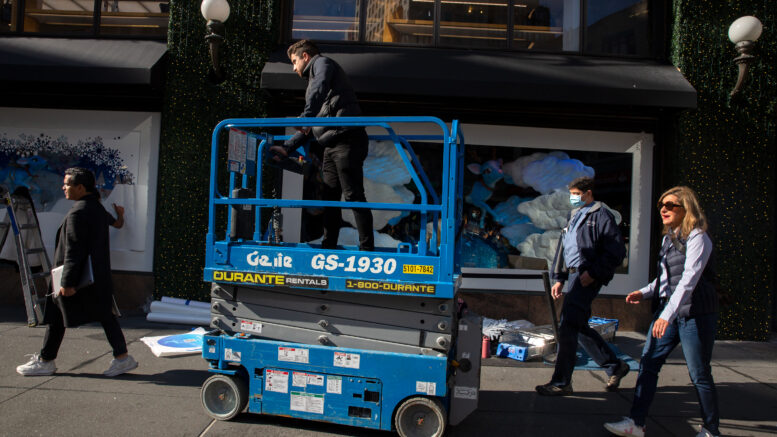New York City’s economy surged back to life in October as rising vaccination rates and falling infection numbers spurred a wave of hiring.
Still, new data underscores deeply embedded inequality in the city — even as the Biden administration struggles to pass a social spending bill that would help New York’s less well-off residents and as Mayor-elect Eric Adams pledges to tackle disparities.
The city gained 83,500 jobs in October, the largest boost since the early months of the pandemic recession recovery in 2020. The increase reached 2%, or twice the rate of the nation as a whole.
It marked the first time in months that the city’s job creation outpaced the rest of the country.
The local unemployment rate dropped slightly to 9.4% from the 9.8% recorded in September. While still much higher than the national rate, the number of unemployed city residents has declined for nine consecutive months.
“New York City infection rates fell from mid-September to the end of October,” said James Parrott, an economist at the New School. “As the virus infection rate goes, so goes the job rebound in the opposite direction.”
Virtually every major sector showed employment gains, led by private colleges and universities, business services, health care and the arts.
One particularly important sign of things to come: the addition of almost 7,000 jobs in child care in the last two months. With schools back to in-person learning, many economists believe the lack of affordable and plentiful child care is keeping many parents, especially women, from rejoining the workforce.
The promising job numbers come ahead of the economically crucial holiday season — the first since the widespread availability of vaccinations — and on the cusp of a critical year that will bring a new mayoral administration and a fierce race for governor.
The One Percent Thrives
New reports, though, show how New York remains one of the most unequal cities in the nation.
The top 1% of taxpayers in New York accounted for some 35% of all the taxable income in the city in 2019, according to data the Independent Budget Office updates annually.
Some 55% of taxpayers made less than $40,000, accounting for less than 10% of all the taxable income in the city.
All signs point to the gap between the rich and the poor growing rapidly in the pandemic — to the point where it may rival 2007, when the 1% accounted for more than 45% of all income. That was also a year in which the stock market boomed and Wall Street handed out big bonuses.
Since March 2020, the benchmark S&P 500 has soared 75% and the tech-heavy Nasdaq index has doubled. The top 1% get less than 40% of its income in wages, with the majority coming from gains in stock and bonds, as well as dividends from both stocks and privately held companies.
Wall Street profits are likely to set a record this year, and bonuses next year are expected to jump by 25% to 30% at securities firms, according to the compensation consultant Johnson Associates.
Last year, the average bonus reached $175,000, according to a report from state comptroller Thomas DiNapoli. Average salary topped $420,000.
CUNY Spotlights Inequality
At the same time, an in-depth study of CUNY students by the Federal Reserve Bank of New York shows how difficult making economic gains are for Black and Hispanic New Yorkers, even at an institution widely touted as a pathway to the middle class.
Black students are more likely than white students to take on debt and to be delinquent on student loans, while lagging in completing degrees, according to the study.
Data on consumer debt shows Black and Hispanic graduates from CUNY are less likely to buy a home or car and to have smaller credit card debt. They also have higher rates of delinquencies than white CUNY alumni.
In addition to racial disparities, women at CUNY do better in school than men, but that doesn’t translate into more spending power.
“You can see a lot of gender and racial inequality in the data,” said Rajashri Chakrabarti, senior economist at the New York Fed. “There is inequality in household debt as well as in delinquencies. Inequality in educational attainment is an important contributor to racial inequality. For gender inequality, structural factors also play a role.”
‘The Great Equalizer’
While city and state governments have limited ability to influence the trends widening inequality in New York, the Biden administration’s embattled $1.7 trillion social spending bill would substantially help poorer residents in the city, said Rep. Ritchie Torres (D-The Bronx).
Two provisions in particular would have a major impact in the city, he contends:
Expanding home care for seniors and lifting pay for home care workers would both improve the finances of seniors — and the women of color who largely provide the care while earning poverty wages.
Making the doubling of the refundable child tax credit permanent would essentially provide Social Security for families with children, lifting those families out of poverty.
“It is the great equalizer,” Torres said.
While watered down, a global minimum tax for corporations and funding aggressive IRS enforcement of the tax laws would also mean companies and the rich would pay their fair share, he added.
Adams, meanwhile, pledged to attack inequality by fighting COVID effectively and investing in infrastructure, job training, help for struggling business and incentives for new industries to move to the city.
“The new jobs data is a good sign that our city is ready to rebound, but we have work to do to ensure that our comeback is equitable, sustainable, and prioritizes those who have been most impacted by the COVID-19 pandemic and historic inequality,” he said in a statement to THE CITY.
This article was originally posted on Jobs Grow — Along With the Pandemic Gap Between Rich and Poor New Yorkers

Be the first to comment on "Jobs Grow — Along With the Pandemic Gap Between Rich and Poor New Yorkers"